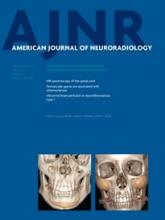Index by author
Ahmed, S.
- EDITOR'S CHOICEHead and Neck ImagingOpen AccessCT Imaging Correlates of Genomic Expression for Oral Cavity Squamous Cell CarcinomaC.R. Pickering, K. Shah, S. Ahmed, A. Rao, M.J. Frederick, J. Zhang, A.K. Unruh, J. Wang, L.E. Ginsberg, A.J. Kumar, J.N. Myers and J.D. HamiltonAmerican Journal of Neuroradiology September 2013, 34 (9) 1818-1822; DOI: https://doi.org/10.3174/ajnr.A3635
CT findings in 27 nontreated patients with oral squamous cell carcinoma were correlated with genomic analysis. Tumor enhancement correlated with presence of vascular endothelial growth factor while epidermal growth factor correlated with mass effect and perineural invasion. Thus, some CT findings may reflect genomic biomarkers.
Alperin, N.
- BrainOpen AccessAutomated Posterior Cranial Fossa Volumetry by MRI: Applications to Chiari Malformation Type IA.M. Bagci, S.H. Lee, N. Nagornaya, B.A. Green and N. AlperinAmerican Journal of Neuroradiology September 2013, 34 (9) 1758-1763; DOI: https://doi.org/10.3174/ajnr.A3435
Ambarki, K.
- BrainOpen AccessMeasuring Pulsatile Flow in Cerebral Arteries Using 4D Phase-Contrast MR ImagingA. Wåhlin, K. Ambarki, R. Birgander, O. Wieben, K.M. Johnson, J. Malm and A. EklundAmerican Journal of Neuroradiology September 2013, 34 (9) 1740-1745; DOI: https://doi.org/10.3174/ajnr.A3442
An, Z.
- EDITOR'S CHOICEBrainYou have accessMetabolite Differences in the Lenticular Nucleus in Type 2 Diabetes Mellitus Shown by Proton MR SpectroscopyY. Lin, J. Zhou, L. Sha, Y. Li, X. Qu, L. Liu, H. Chen, Z. An, Y. Wang and C. SunAmerican Journal of Neuroradiology September 2013, 34 (9) 1692-1696; DOI: https://doi.org/10.3174/ajnr.A3492
A group of 22 patients with type 2 diabetes underwent MR spectroscopy of the deep gray matter nuclei and their metabolite ratios of NAA/Cr and Cho/Cr were assessed and correlated with laboratory findings. Metabolite ratios were different in the left and right lenticular nuclei and in the thalami, suggesting that diabetes affects these differently with the former being more vulnerable than the latter. The metabolic abnormalities preceded anatomic lesions.








